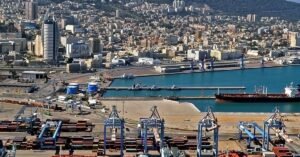Haifa is Israel’s largest port, situated on its northern Mediterranean coast.
It was managed by the state-owned Haifa Port Company, but to boost competition and bring about efficiency, the government rolled out privatisation reforms.

In July 2022, Adani Ports and Special Economic Zone Ltd. (India) and Israel’s Gadot Group won the tender to operate the port under a long-term concession.
This consortium was a significant step in transforming Haifa into a major international port with improved infrastructure, digital operations and expanded trade and opportunities.
Haifa Port handles about 20 million tons of cargo annually, and its container throughput exceeds 1 million TEUs per year, making it the busiest container port in Israel until recently, when Ashdod and the new Bayport started sharing the load.
Port Facilities
Within the port is a basin spanning 1,066,000 m2, comprising the main port and Kishon Harbour, towards the eastern side. The land area covers more than 4,500,000 m2.
Haifa Port at the foot of Mount Carmel is a naturally deep and sheltered bay equipped with modern infrastructure and plays a central role in Israel’s maritime trade and logistics. It handles most of the imports and exports and functions as a link between Europe, Asia and the Middle East.
Major exports from Haifa include chemicals, tires, electronics, industrial products, machinery, textiles and citrus fruits. Imports include grain, vehicles, oil and petroleum products, consumer goods and raw materials.
Terminals At Haifa Port In Israel
The port has two breakwaters, the main breakwater spanning 2.8 km and the Lee breakwater, which is 760 m long.
The Carmel Container Terminal is the main container terminal at Haifa. It is 700 m long and 15.8 m deep.
It can store 25,000 containers and has 8 bridge cranes. The Eastern Terminal for Containers is 960 m long and 13.5 m deep and is equipped with Panamax and Post-Panamax Cranes.

The Offshore chemical berth at Akko, 6NM NE, is serviced by Haifa pilots.
General Cargo and Bulk Cargo are handled at the Kishon Area, which can accommodate ships with a DWT of 25,000 tonnes and has a 9.5 m draft.
The Chemicals Terminal has an 8.5 m draft, while the Central Wharf handles RORO and General Cargo. The Dagon Terminal handled grain and ships up to 66,000 DWT with a 14 m draft.
The Cruise Terminal at Haifa Port is the main gateway for tourists visiting northern Israel. It is a modern facility which serves cruise and ferry passengers.
It offers many services and has amenities like waiting areas, duty-free shops and dining options. The terminal is close to downtown Haifa and the Haifa Centre Railway Station.
The port is close to road and railway networks, enabling efficient inland distribution and is also near Haifa’s industrial zones and high-tech centres.
Port Expansion and Modernisation
Haifa has seen massive investments in infrastructure, including-
Bayport Terminal: This new facility, close to the existing port, was developed to accommodate ultra-large container vessels. It is operated by the Shanghai International Port Group and began operations in 2021.
The port has also embraced automation, smart port technologies and the use of AI-based logistics systems, including real-time monitoring for improving turnaround times and reducing costs.
Haifa has also integrated eco-friendly practices, such as using electric vehicles for port operations and focusing on waste management.
Though Haifa remains an important facility, it faces increased competition from Ashdod port, lying further south, and the Bayport Terminal or the New Haifa Port, designed to serve mega-ships, drawing some maritime traffic away from the old port.
Traditionally, Haifa Port has contributed enormously to the growth of Israel. The city of Haifa is also home to many oil refineries, the Matam Business Park and universities, making it a centre of innovation, research and development.
Impact of the Israel-Iran War on Haifa Port Operations
As of June 17, 2025, Israeli Officials and the Adani Group have confirmed that the port was not damaged from Iranian ballistic missile strikes and remains fully operational.
However, the nearby Bazan Oil Refinery was hit and was temporarily closed, with 3 workers killed in the accident. This has led to greater calls for the closure of the facility due to safety concerns amidst Israel’s conflict with Iran.
War Risk Insurance for ships headed to Israeli Ports, including Haifa, has surged, now costing 0.7 to 1.0% per voyage, up from 0.2% as the conflict continues to escalate.
Regional oil prices have also been impacted by the escalation, driven by concerns over potential disruptions in the Hormuz Strait.
Houthis have also declared to target Haifa Port and imposed a blockage, which has increased risks for vessels heading to and from the port, though no severe disruptions have been reported so far.
The maritime security situation remains tense, with ongoing threats from Iranian proxies and periodic missile alerts, but the port’s logistics and shipping activities are stable as per the latest updates.
You might also like to read-
- 5 Major Ports in Bahrain
- What Are The Major Ports In Jordan?
- Major Ports In Lebanon
- 5 Major Ports in Libya
- 7 Major Ports in Kazakhstan

